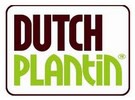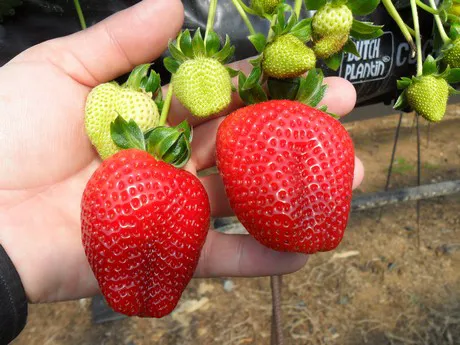
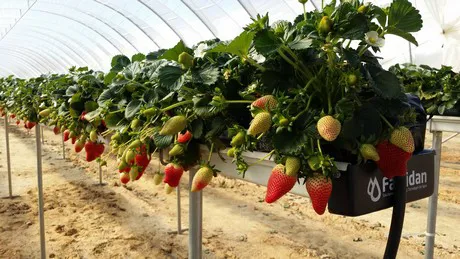
Spain discovers coconut substrate
The province of Huelva is located in the south-western tip of Spain. Thirty years ago, no one here had ever heard of irrigation systems. That all changed when Carmelo del Toro settled here in 1989 and grew to be a complete specialist in the field of fully automated irrigation systems. His son Miguel del Toro Peters tells us more about the market developments. “Here in Spain, the rules pertaining to water conservation get stricter every year”, he says. "That presents a major challenge to farmers."
Substrates
In addition to developing automated irrigation systems, the Famidan company also introduced the process of growing strawberries on substrates in Spain. That was in 1996. Since then, the cultivation of strawberries and even raspberries has taken off in Spain, and Famidan's systems are largely responsible for that.
“These days, coconut substrates are used on a large scale. Recently, farmers even started using it to grow blueberries,” Miguel del Toro Peters explains. “We are currently fully committed to conducting more experiments in that area. We use the double-layer growbags produced by Dutch Plantin to this end. We were so enthusiastic about this product for strawberries that we asked Dutch Plantin to also develop a growbag specifically designed for blueberries."
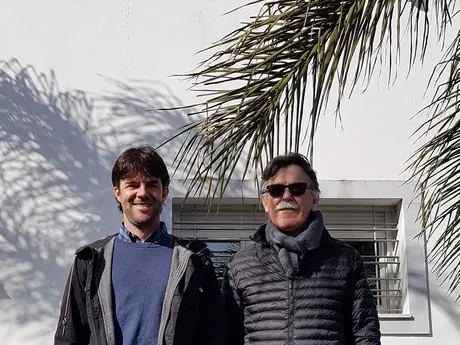
Blueberries
The double-layer growbag was developed some years ago and distinguishes itself thanks to the coarse coco pith on top (for fast taking of the crop and a perfect horizontal rooting) and coco chips on the bottom (for uniform and easy drainage). Wim Roosen of Dutch Plantin explains how a special mix for the blueberries was developed. "With hydroponic cultivation being a solution to soft fruit growers in these areas and our products being a solution to hydroponic growers, we see the demand not only for our coir products is on the rise, but also the demand for knowledge on hydroponic cultivation. We help growers not only with the products specialized for their crop, but also with the knowledge we gained on these topics."
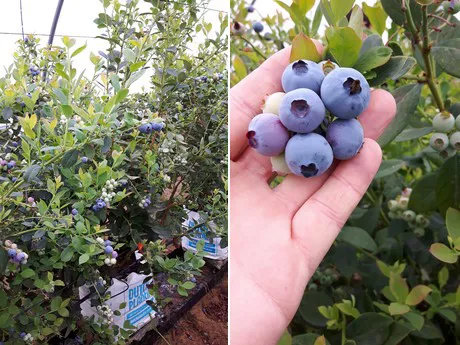
Steep slopes
Does Spain present different challenges when it comes to cultivating soft fruits, compared to the Netherlands? Miguel is sure of it. “The slopes are quite steep here, which presents the risk of the plants in the lower areas drowning whereas those higher up are drying out. A precision irrigation system is a must to realize the optimal growth of the blueberry plant’s roots as well as of the plant itself.”
Famidan sees how growers are already achieving excellent results with their systems and still continue to develop them further. "Our computer systems are all custom solutions. Advanced monitoring sensors control the irrigation process and regulate the exact amount of water that each plant receives, no matter where it is planted.”
Sensors
Miguel believes these sensors are the foremost
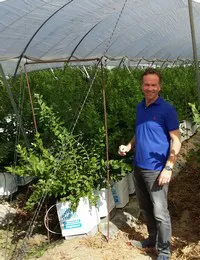 innovation in the field of irrigation. “They continuously measure the moistness of the soil, in the pots and in the substrates and control the fully automated irrigation systems. This allows us to guarantee an optimal demand-driven irrigation process, so that every plant gets exactly what it needs regardless of whether it is planted at the bottom of the valley or on top of the hill. At the same time, it helps avoid the wastage of water and fertilizer and keeps these from leaking down to e.g. lower areas. In Spain, the rules pertaining to water consumption are getting stricter every year. That presents a major challenge to farmers. However, we are convinced that this combination of substrates and a fully automated irrigation system will allow us to meet these changing environmental requirements."
innovation in the field of irrigation. “They continuously measure the moistness of the soil, in the pots and in the substrates and control the fully automated irrigation systems. This allows us to guarantee an optimal demand-driven irrigation process, so that every plant gets exactly what it needs regardless of whether it is planted at the bottom of the valley or on top of the hill. At the same time, it helps avoid the wastage of water and fertilizer and keeps these from leaking down to e.g. lower areas. In Spain, the rules pertaining to water consumption are getting stricter every year. That presents a major challenge to farmers. However, we are convinced that this combination of substrates and a fully automated irrigation system will allow us to meet these changing environmental requirements." 